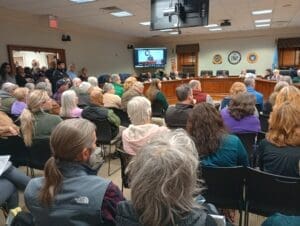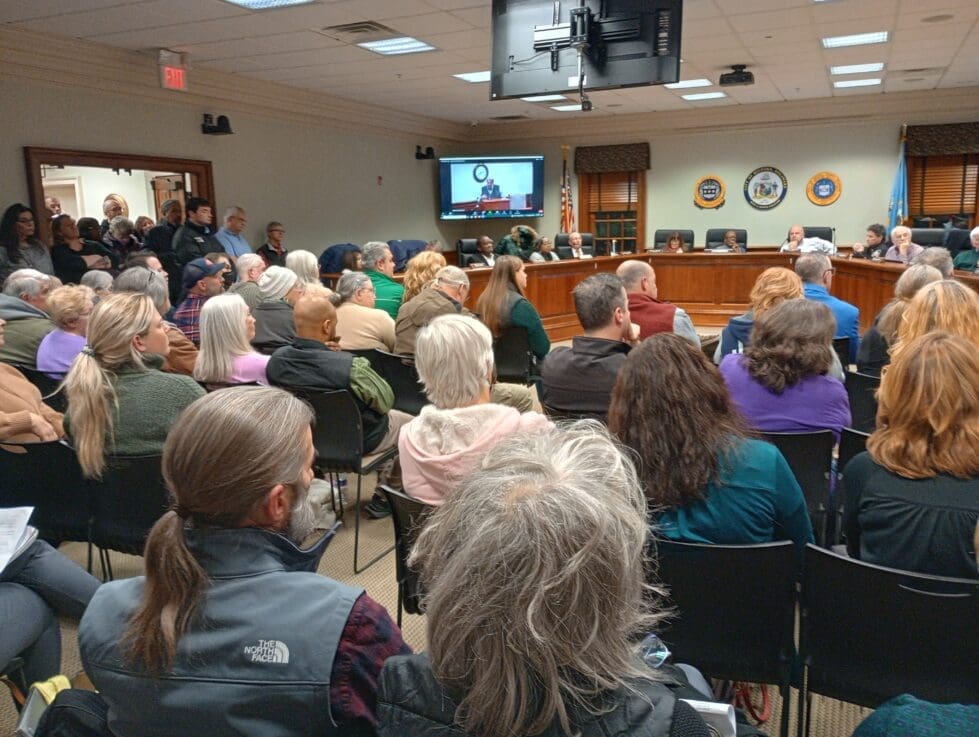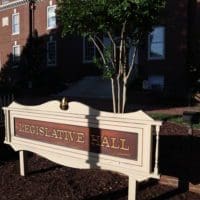

A Milford council hearing about a proposed tiny house village for the homeless drew overflow crowds Monday night. Photo by Katie Kazimir
A Milford City Council hearing on a proposed tiny house village for the homeless packed the council chamber, lobby and a basement overflow room on Monday with people who spent four hours expressing their opinions.
No vote was taken.
Everyone who spoke agreed that it was important to help the homeless. They also stressed that the city should do something to help with skyrocketing apartment and home costs.
But many opposed the plan to put 40 small houses on property either near the old and new police stations or near a former homeless encampment on the city’s west side.
The village would be built by non-profit Springboard Collaborative, which opened a homeless village in Georgetown last year.
A recurring theme from supporters was that it was the town’s Christian duty to approve the plan for the village.
One woman, however, took the microphone to announce she was Christian, but did not want the village.
Those opposed, mostly local business owners, urged the council to consider the impact a homeless village would have on Milford’s larger economic picture, especially being built in what’s considered a gate to the community.
“It’s not a good look,” said downtown business owner Marissa King, a business owner and the first to speak when the council asked for comment from people who opposed the project.
A homeless village would drive down the local economy because of the fear factor, many said. They cited public safety concerns about mental issues and substance abuse, common among the homeless.
Several of those opposed suggested a location further from the business district would be a better solution, King said.
Many residents said they were worried about increased time and safety, especially walking after dark, and increased crime.
Carrie Casey, general manager of the county’s Department of Community Services, said that 15% of the 3,470 residents that the New Castle County Hope Center has taken care of come from Kent and Sussex County.
“That’s more than 500 people who have had to be displaced from where they know their children go to school,” she said. “People want to be able to get their life back in the town where they live and where their community is.”
Village financing
The Springboard Collaborative received $1.4 million in American Rescue Plan money to build a central Sussex village, and they want to do it in Milford. The money will cover site plans, lawyer fees and more.
The Milford village will cost about $1 million a year to operate, the same as Georgetown’s, said Springboard Executive Director Judson Malone on Tuesday.
That breaks down to about $65 per day per person since there are 40 to 50 people per village, and most goes to staffers who oversee the site and occupants.
“It may seem like a lot,” Malone said, but it’s similar to the costs the state paid for housing vouchers during the COVID-19 epidemic.
Additional costs that will be covered include utilities, insurance, business expenses or anything associated with the operating the facility, Malone said.
In Georgetown, the land is being borrowed under a temporary land use agreement, with no conditions from the planning for zoning commission.
In Milford the agency is seeking a conditional use for a shelter agreement.
To do that Springboard has to establish a site, develop a site plan, go before the planning committee, have a public hearing, go before the council, have another public hearing and then a council vote.
Georgetown’s village operation is funded through foundation grants and donations.
“That’s not sustainable in the long run,” Malone said.
Once Milford’s village is built, he expects the state to contract for specialized services, often provided by the Division of Health and Social Services.
The Georgetown village is connected with nonprofits that help the residents work through the processes needed to get permanent housing.
Malone hopes to have the state agree to fund the two organizations at $1 million a year each.
“It could be very creative,” he said, even a spread between county, state and federal money from places such as Housing and Urban Development and the U.S. Department of Agriculture.
“It’s complicated, but it’s doable, ” he said.
Placing people in homes
During the Monday hearing, Malone said residents are screened and once approved assigned a caseworker to navigate steps toward permanent housing.
“They can focus on other aspects of their life,” Malone said, aspects that have been impeding their goal of long term housing.
The goal is for residents to stay until they are successful in finding permanent housing, which is expected to take place within two years.
Since opening in August, the Georgetown Springboard Village has served 53 people, according to its website.
Malone said in the meeting that 11 participants – or 20% – have reached the goal of steady housing.
Advocates for the project spoke about how homeless people are more successful finding permanent homes when they have a safe temporary place to stay during the transition.
IN THE NEWS: Committee wrestles with porn content sent to minors
Milford resident John Davis said he had property in both Milford and Georgetown next to the Springboard Village.
In Georgetown, he said, he had about 20 homeless people living in the woods on his property, but after the village was put there, it doubled to 40.
He gives them odd jobs and sometimes some money, but it’s a burden, he said.
Police asked him to evict the homeless there, but he says he can’t and won’t until he decides how to develop the property.
“The problem is, more people move in,” he said.
He opposed the Milford project, saying it is a burden for nearby landowners and he’s concerned about what the consequences will be.
Fears about taxes
Several opponents feared the village would draw more people seeking transitional housing to Milford, straining existing resources and infrastructure.
Should the state pull funding from the operation of the Springboard Village, costs would have to be covered by the city.
That would result in a potential increase for city tax payers, which landlords and developers would pass on to renters and homebuyers.
The result would make it even more expensive for people to obtain and sustain permanent housing as rents and home prices would increase, opponents said.
One person pointed out that the city had just raised taxes to build a new police station and the school board raised taxes for school.
How a village works
There are three models: a single one bedroom; a duplex with two bedrooms; and a family size with two beds and a bathroom. Couples and pets are allowed.
The residents do not have a curfew.
The pallets used to create the homes are easily deployed and can be moved from one municipality to another.
The residents meet with caseworkers at least every three months.
As long as the residents are making progress toward a housing plan they are considered successful and allowed to stay. If they don’t make progress, they are considered unsuccessful, Malone said.
He said the organizers originally planned on a maximum one-year stay, but raised it to two years because there is a two- to three-year waitlist that apparently became longer this year.
And, he said, there’s not enough affordable housing to be able to guarantee someone a place within two years.
The Georgetown’s village workers include:
- A project director who runs the village.
- Two community navigators, each with a caseload of about 20 people
- About one dozen shelter coordinators, with two working for each evening and overnight shift and at least one during the day and on weekends
- A shelter supervisor who manages the workforce security. They knock on every door every night to check in with the residents and monitor their coming and going.
- A couple of people who handle meal service, which includes a continental breakfast, hot lunch and evening meal.
Share this Post








